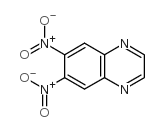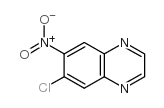6,7-Dinitroquinoxaline
Modify Date: 2024-01-06 12:17:51

6,7-Dinitroquinoxaline structure
|
Common Name | 6,7-Dinitroquinoxaline | ||
|---|---|---|---|---|
| CAS Number | 68836-13-5 | Molecular Weight | 220.14200 | |
| Density | 1.646g/cm3 | Boiling Point | 456ºC at 760 mmHg | |
| Molecular Formula | C8H4N4O4 | Melting Point | 188-191ºC | |
| MSDS | N/A | Flash Point | 229.6ºC | |
| Name | 6,7-Dinitroquinoxaline |
|---|---|
| Synonym | More Synonyms |
| Density | 1.646g/cm3 |
|---|---|
| Boiling Point | 456ºC at 760 mmHg |
| Melting Point | 188-191ºC |
| Molecular Formula | C8H4N4O4 |
| Molecular Weight | 220.14200 |
| Flash Point | 229.6ºC |
| Exact Mass | 220.02300 |
| PSA | 117.42000 |
| LogP | 2.49260 |
| Index of Refraction | 1.73 |
Synonym: Section 2 - COMPOSITION, INFORMATION ON INGREDIENTS
Risk Phrases: None Listed. Section 3 - HAZARDS IDENTIFICATION EMERGENCY OVERVIEW
The toxicological properties of this material have not been fully investigated. Potential Health Effects Eye: May cause eye irritation. Skin: May cause skin irritation. Ingestion: The toxicological properties of this substance have not been fully investigated. Inhalation: May cause respiratory tract irritation. Chronic: Not available. Section 4 - FIRST AID MEASURES Eyes: Flush eyes with plenty of water for at least 15 minutes, occasionally lifting the upper and lower eyelids. Get medical aid. Skin: Flush skin with plenty of water for at least 15 minutes while removing contaminated clothing and shoes. Get medical aid if irritation develops or persists. Ingestion: Get medical aid. Wash mouth out with water. Inhalation: Remove from exposure and move to fresh air immediately. Get medical aid if cough or other symptoms appear. Notes to Physician: Section 5 - FIRE FIGHTING MEASURES General Information: As in any fire, wear a self-contained breathing apparatus in pressure-demand, MSHA/NIOSH (approved or equivalent), and full protective gear. Extinguishing Media: Use water spray, dry chemical, carbon dioxide, or chemical foam. Section 6 - ACCIDENTAL RELEASE MEASURES General Information: Use proper personal protective equipment as indicated in Section 8. Spills/Leaks: Vacuum or sweep up material and place into a suitable disposal container. Section 7 - HANDLING and STORAGE Handling: Avoid breathing dust, vapor, mist, or gas. Avoid contact with skin and eyes. Use only in a chemical fume hood. Storage: Store in a cool, dry place. Store in a tightly closed container. Section 8 - EXPOSURE CONTROLS, PERSONAL PROTECTION Engineering Controls: Facilities storing or utilizing this material should be equipped with an eyewash facility and a safety shower. Exposure Limits CAS# 68836-13-5: Personal Protective Equipment Eyes: Wear chemical splash goggles. Skin: Wear appropriate protective gloves to prevent skin exposure. Clothing: Wear a chemical apron. Respirators: A NIOSH/MSHA approved air purifying dust or mist respirator or European Standard EN 149. Section 9 - PHYSICAL AND CHEMICAL PROPERTIES Physical State: Solid Color: slightly yellow Odor: Not available. pH: Not available. Vapor Pressure: Not available. Viscosity: Not available. Boiling Point: Not available. Freezing/Melting Point: 188 - 190 deg C Autoignition Temperature: Not available. Flash Point: Not available. Explosion Limits, lower: Not available. Explosion Limits, upper: Not available. Decomposition Temperature: Solubility in water: Specific Gravity/Density: Molecular Formula: C8H4N4O4 Molecular Weight: 220.14 Section 10 - STABILITY AND REACTIVITY Chemical Stability: Stable under normal temperatures and pressures. Conditions to Avoid: None reported. Incompatibilities with Other Materials: Strong oxidizing agents. Hazardous Decomposition Products: Carbon monoxide, carbon dioxide. Hazardous Polymerization: Has not been reported. Section 11 - TOXICOLOGICAL INFORMATION RTECS#: CAS# 68836-13-5 unlisted. LD50/LC50: Not available. Carcinogenicity: 6,7-Dinitroquinoxaline, 99% - Not listed by ACGIH, IARC, or NTP. Section 12 - ECOLOGICAL INFORMATION Section 13 - DISPOSAL CONSIDERATIONS Dispose of in a manner consistent with federal, state, and local regulations. Section 14 - TRANSPORT INFORMATION IATA Not regulated as a hazardous material. IMO Not regulated as a hazardous material. RID/ADR Not regulated as a hazardous material. Section 15 - REGULATORY INFORMATION European/International Regulations European Labeling in Accordance with EC Directives Hazard Symbols: Not available. Risk Phrases: Safety Phrases: S 24/25 Avoid contact with skin and eyes. WGK (Water Danger/Protection) CAS# 68836-13-5: No information available. Canada None of the chemicals in this product are listed on the DSL/NDSL list. CAS# 68836-13-5 is not listed on Canada's Ingredient Disclosure List. US FEDERAL TSCA CAS# 68836-13-5 is not listed on the TSCA inventory. It is for research and development use only. SECTION 16 - ADDITIONAL INFORMATION N/A |
| Hazard Codes | Xn |
|---|---|
| Risk Phrases | R20/21/22;R36/37/38 |
| Safety Phrases | S26;S36/S37/S39 |
| Precursor 0 | |
|---|---|
| DownStream 2 | |
| 6,7-dinitro-quinoxaline |
| 6,7-Dinitrochinoxalin |
| MFCD00067070 |
 CAS#:19853-64-6
CAS#:19853-64-6 CAS#:109541-21-1
CAS#:109541-21-1